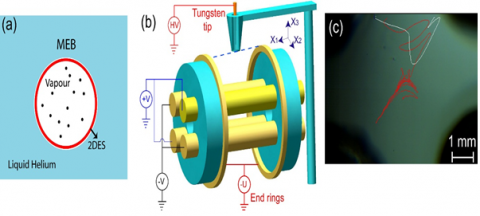
Investigations of two-dimensional electron systems (2DES) have been achieved with two model experimental systems, covering two distinct, non-overlapping regimes of the 2DES phase diagram, namely the quantum liquid phase in semiconducting heterostructures and the classical phases observed in electrons confined above the surface of liquid helium. Multielectron bubbles in liquid helium offer an exciting possibility to bridge this gap in the phase diagram, as well as to study the properties of electrons on curved flexible surfaces. However, this approach has been limited because all experimental studies have so far been transient in nature. Here we demonstrate that it is possible to trap and manipulate multielectron bubbles in a conventional Paul trap for several hundreds of milliseconds, enabling reliable measurements of their physical properties and thereby gaining valuable insight to various aspects of curved 2DES that were previously unexplored [1].
Figure: (a) Schematic of a multielectron bubble (MEB) (b) Schematic of the experimental setup to generate and trap MEBs. Field emission from the tungsten tip charges the liquid helium surface; the four horizontal metal rods of diameter 3 mm and separated diagonally by 5 mm provide the trapping electric field while the end rings confine the MEBs to the trap centre. Dotted line indicates the level of liquid helium. (c) Trajectory for a stably trapped MEB (red), along with that of an MEB, which rose up due to buoyancy and left the trap (white). The view of the camera was along the X1 axis, that is, along the length of the rods.
[1] V. Vadakkumbatt, E. Joseph, A. Pal and A. Ghosh, Nature communications 5, (2014).
